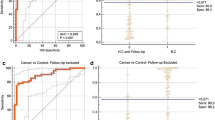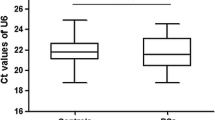Abstract
Because of low sensitivity and specificity of the currently available urine biomarkers of bladder cancer (BC) detection and painful cystoscopy procedure. Our study aimed to evaluate expression of urinary exosomal miR-96-5p and miR-183-5p as probable non-invasive and accurate biomarkers for the diagnosis and follow up of BC. Using quantitative real-time polymerase chain reaction; expression of exosomal microRNA (miR)-96-5p and miR- 183-5p in the urine samples of 51 patients with BC, 21 patients with benign urinary bladder lesions and in 24 normal individuals as control group was done. Our study results showed higher expressions of both miR-96-5p and miR-183-5p in urine of BC patients in comparison with control group (P < 0.001 for each). Receiver operating characteristic curve (ROC) analysis showed that each microRNA had good sensitivity and specificity to differentiate BC from non-BC patients miR-96-5p 80.4% and 91.8% and miR-183-5p 78.4% and 81.6% respectively compared to cytology (37.3% and 100%). In addition, it was obvious that the sensitivity of combined miR-96-5p and miR-183-5p for the diagnosis of BC reached 88.2%% and specificity reached 87.8%, which were higher than each one alone. We also found that expression of miR-96-5p and miR-183-5p with high grade, and pathological stage was significantly increased. After surgery, collected urine samples showed significantly lower expression of miR-96-5p-: P < 0.001; and miR-183-5p: P = 0.002. In conclusion, urine miR-96-5p and miR-183-5p are promising tumor biomarkers of BC diagnosis; particularly, when they combined with each other or with urinary cytology.



Similar content being viewed by others
Data availability
Data available on request due to privacy/ethical restrictions.
References
Ferlay J, Colombet M, Soerjomataram I, Mathers C, Parkin DM, Piñeros M, Znaor A, Bray F (2019) Estimating the global cancer incidence and mortality in 2018: GLOBOCAN sources and methods. Int J Cancer 144:1941–1953
Wong MCS, Fung FDH, Leung C, Cheung W, Goggins WB et al (2018) The Global Epidemiology of Bladder Cancer: a joinpoint regression analysis of its incidence and mortality trends and projection. Sci Rep. 8(1):1129
Ming Zhao M, He X, Teng X (2016) Understanding the molecular pathogenesis and prognostics of bladder cancer: an overview. Chin J Cancer Res 28(1):92–98
Mossanen M (2021) The epidemiology of bladder cancer. Hematol Oncol Clin North Am 35(3):445–455
Burger M, Catto JWF, Dalbagni G et al (2013) Epidemiology and risk factors of urothelial bladder cancer. Eur Urol 63:234–241
Redondo-Gonzalez E, de Castro LN, Moreno-Sierra J, Maestro de las Casas ML, Vera-Gonzalez V, Ferrari DG et al (2015) Bladder carcinoma data with clinical risk factors and molecular markers: a cluster analysis. Biomed Res Int 2015:168682
Zhu CZ, Ting HN, Ng KH, Ong TA (2019) A review on the accuracy of bladder cancer detection methods. J Cancer 10:4038–4044
Zhang B, Wang Q, Pan X (2007) MicroRNAs and their regulatory roles in animals and plants. J Cell Physiol 210:279–289
Lin YC, Chen TH, Huang YM, Wei PL, Lin JC (2021) Involvement of microRNA in solid cancer: role and regulatory mechanisms. Biomedicines 9(4):343
Valadi H, Ekstrom K, Bossios A, Sjöstrand M, Lee JJ, Lötvall JO (2007) Exosome-mediated transfer of mRNAs and microRNAs is a novel mechanism of genetic exchange between cells. Nat Cell Biol 9:654–659
Amuran GG, Eyuboglu IP, Tinay I, Akkiprik M, Amuran GG et al (2018) New insights in bladder cancer diagnosis: urinary miRNAs and proteins. Med Sci (Basel) 6(4):113
Batista R, Vinagre N, Meireles S, Vinagre J, Prazeres H, Leão R et al (2020) Biomarkers for bladder cancer diagnosis and surveillance: a comprehensive review. Diagnostics 10:39
Yamada Y, Enokida H, Kojima S, Kawakami K, Chiyomaru T, Tatarano S et al (2011) MiR-96 and miR183 detection in urine serve as potential tumor markers of urothelial carcinoma: correlation with stage and grade, and comparison with urinary cytology. Cancer Sci 102(3):522–529
Liu B, Zhang J, Yang D (2019) JmiR-96-5p promotes the proliferation and migration of ovarian cancer cells by suppressing Caveolae1. Ovarian Res 12(1):57
Anderson O, Guttilla Reed IK (2020) Regulation of cell growth and migration by miR-96 and miR-183 in a breast cancer model of epithelial–mesenchymal transition. PLoS ONE 15(5):e0233187
Yoshino H, Seki N, Itesako T, Chiyomaru T, Nakagawa M, Enokida H (2013) Aberrant expression of microRNAs in bladder cancer. Nat Rev Urol 10:396–404
Cao D, Di M, Liang J, Shi S, Tan Q, Wang Z (2020) MicroRNA-183 in cancer progression. J Cancer 11(6):1315–1324
Erdmann K, Salomo K, Klimova A, Heberling U, Lohse-Fischer A, Fuehrer R, Thomas C, Roeder I, Froehner M, Wirth MP, Fuessel S (2020) Urinary MicroRNAs as potential markers for non-invasive diagnosis of bladder cancer. Int J Mol Sci 21(11):3814
Osaki M, Okada F (2019) Exosomes and their role in cancer progression. Yonago Acta Med 62(2):182–190
Roma-Rodrigues C, Fernandes AR, Baptista PV (2014) Exosome in tumour microenvironment: overview of the crosstalk between normal and cancer cells. Biomed Res Int 2014:179486
Piao X, Cha E, Yun SJ, Kim W (2021) Role of exosomal miRNA in bladder cancer: a promising liquid biopsy biomarker. Int J Mol Sci 22(4):1713
de Oliveira MC, Caires HR, Oliveira MJ, Fraga A, Vasconcelos MH, Ribeiro R (2020) Urinary biomarkers in bladder cancer: where do we stand and potential role of extracellular vesicles. Cancers (Basel) 12(6):1400
Greene FL, Page DL, Flemming ID, Fritz AG, Balch CM, Haller DG et al (2002) American joint committee on cancer staging manual, 6th edn. Springer, New York, pp 337–346
Yorukoglu K, Tuna B, Dikicioglu E, Duzcan E, Isisag A, Sen S et al (2003) Reproducibility of the 1998 World Health Organization/International Society of Urologic Pathology classification of papillary urothelial neoplasms of the urinary bladder. Virchows Arch 443:734–740
Szeto CC, Ching-Ha KB, Ka-Bik L, Mac-Moune LF, Cheung-Lung CP, Gang W, Kai- Ming C, Kam-Tao LP (2012) Micro-RNA expression in the urinary sediment of patients with chronic kidney diseases. Dis Mark 33(3):137–144
Normalization control for real-time PCR analysis of microRNA using SYBR Green detection (2011) miScript PCR System Handbook, 4th edn, pp 15
Matboli M, Labib ME, Nasser HE, El-Tawdi AHF, Habib EK, Labib RA (2020) Exosomal miR-1298 and lncRNA-RP11-583F2.2 expression in hepato-cellular carcinoma. Curr Genomics 21(1):46–55
Li H, Xie S, Liu M, Chen Z, Liu X, Wang L, Li D, Zhou Y (2014) The clinical significance of downregulation of mir-124-3p, mir-146a-5p, mir-155-5p and mir-335-5p in gastric cancer tumorigenesis. Int J Oncol 45(1):197–208
Terracciano D, Ferro M, Terreri S, Lucarelli G, D’Elia C, Musi G et al (2017) Urinary long noncoding RNAs in nonmuscle-invasive bladder cancer: new architects in cancer prognostic biomarkers. Transl Res 184:108–117
Terreri S, Mancinelli S, Ferro M, Vitale MC, Perdonà S, Castaldo L (2021) Subcellular localization of uc.8+ as a prognostic biomarker in bladder cancer tissue. Cancers (Basel) 13(4):681
Cheng L, Sharples RA, Scicluna BJ, Hill AF (2014) Exosomes provide a protective and enriched source of miRNA for biomarker profiling compared to intracellular and cell-free blood. J Extracell Vesicles 3:23743
Cheng L, Sun X, Scicluna BJ, Coleman BM, Hill AF (2014) Characterization and deep sequencing analysis of exosomal and non-exosomal miRNA in human urine. Kidney Int 86(2):433–444
Baumgart S, Hölters S, Ohlmann C, Bohle R, Stöckle M, Ostenfeld MS (2017) Exosomes of invasive urothelial carcinoma cells are characterized by a specific miRNA expression signature. Oncotarget 8(35):58278–58291
Armstrong DA, Green BB, Seigne JD, Schned AR, Marsit CJ (2015) MicroRNA molecular profiling from matched tumor and bio-fluids in bladder cancer. Mol Cancer 14:194
Matsuzaki K, Fujita K, Jingushi K, Kawashima A, Ujike T, Nagahara A et al (2017) MiR-21-5p in urinary extracellular vesicles is a novel biomarker of urothelial carcinoma. Oncotarget 8:24668–24678
Baumgart S, Meschkat P, Edelmann P, Hartmann A, Bohle R, Pryalukhin A et al (2018) Invasion-associated miRNAs as possible diagnostic biomarkers of muscle invasive bladder cancer in tumor tissues and urinary exosomes. J Urol 199:e1038
Mengual L, Lozano JJ, Ingelmo-Torres M, Gazquez C, Ribal MJ, Alcaraz A (2013) Using microRNA profiling in urine samples to develop a non-invasive test for bladder cancer. Int J Cancer 133:2631–2641
Urquidi V, Netherton M, Gomes-Giacoia E, Serie DJ, Eckel-Passow J, Rosser CJ, Goodison S (2016) A microRNA biomarker panel for the non-invasive detection of bladder cancer. Oncotarget 7:86290–86299
Guttilla IK, White BA (2009) Coordinate regulation of FOXO1 by miR-27a, miR-96, and miR-182 in breast cancer cells. J Biol Chem 284:23204–23216
Myatt SS, Wang J, Monteiro LJ, Christian M, Ho KK, Fusi L et al (2010) Definition of microRNAs that repress expression of the tumor suppressor gene FOXO1 in endometrial cancer. Cancer Res 70:367–377
Li J, Fu H, Xu C, Tie Y, Xing R, Zhu J et al (2010) miR-183 inhibits TGF-beta1-induced apoptosis by downregulation of PDCD4 expression in human hepatocellular carcinoma cells. BMC Cancer 10:354
Yu S, Lu Z, Liu C, Meng Y, Ma Y, Zhao W et al (2010) miRNA-96 suppresses KRAS and functions as a tumor suppressor gene in pancreatic cancer. Cancer Res 70:6015–6025
Zhu J, Feng Y, Ke Z, Yang Z, Zhou J, Huang X et al (2012) Down-regulation of miR-183 promotes migration and invasion of osteosarcoma by targeting Ezrin. Am J Pathol 180(6):2440–2451
Hannafon BN, Sebastiani P, de Las MA, Lu J, Rosenberg CL (2011) Expression of microRNA and their gene targets are dysregulated in preinvasive breast cancer. Breast Cancer Res 13(2):R24
Eissa S, Habib H, Ali E, Kotb Y (2015) Evaluation of urinary miRNA-96 as a potential biomarker for bladder cancer diagnosis. Med Oncol 32:413
Eissa S, Matboli M, Essawy NO, Kotb YM (2015) Integrative functional genetic-epigenetic approach for selecting genes as urine biomarkers for bladder cancer diagnosis. Tumour Biol 36:9545–9552
Szarvas T, Kovalszky I, Bedi K, Szendroi A, Majoros A et al (2007) Deletion analysis of tumor and urinary DNA to detect bladder cancer: urine supernatant versus urine sediment. Oncol Rep 18:405–409
Chang HW, Tsui KH, Shen LC, Huang HW, Wang SN et al (2007) Urinary cell-free DNA as a potential tumor marker for bladder cancer. Int J Biol Mark 22:287–294
Zhang D, Lau K, Chan ESY, Wang G, Szeto C, Wong K et al (2014) Cell-free urinary MicroRNA-99a and MicroRNA-125b are diagnostic markers for the non-invasive screening of bladder cancer. PLoS ONE 9(7):e100793
Eissa S, Matboli M, Hegazy MG, Kotb YM, Essawy NO (2015) Evaluation of urinary microRNA panel in bladder cancer diagnosis: relation to bilharziasis. Transl Res 165:731–739
Wang Y, Luo H, Li Y, Chen T, Wu S, Yang L (2012) hsa-miR-96 up-regulates MAP4K1 and IRS1 and may function as a promising diagnostic marker in human bladder urothelial carcinomas. Mol Med Rep 5(1):260–265
Lee J, Yun SJ, Jeong P, Piao X, Kim Y, Kim J et al (2018) Identification of differentially expressed miRNAs and miRNA-targeted genes in bladder cancer. Oncotarget 9(45):27656–27666
Wu Z, Liu K, Wang Y, Xu Z, Meng J, Gu S (2015) Upregulation of microRNA-96 and its oncogenic functions by targeting CDKN1A in bladder cancer. Cancer Cell Int 14(15):107
Gao J, Huang L, Huang Z, He R (2018) Clinical value and potential pathways of miR-183–5p in bladder cancer: a study based on miRNA-seq data and bioinformatics analysis. Oncol Lett 15(4):5056–5070
Funding
None.
Author information
Authors and Affiliations
Contributions
All the authors shared in: Design of the work, data collection, data analysis and interpretation, drafting and revision of the article.
Corresponding author
Ethics declarations
Conflict of interest
The authors declare that they have no conflict of interest.
Ethical approval
Written consent was obtained from all participants. The study was approved by the research ethical committee of our institutes. The study was done according to The Code of Ethics of the World Medical Association (Declaration of Helsinki) for studies involving humans.
Additional information
Publisher's Note
Springer Nature remains neutral with regard to jurisdictional claims in published maps and institutional affiliations.
Rights and permissions
About this article
Cite this article
El-Shal, A.S., Shalaby, S.M., Abouhashem, S.E. et al. Urinary exosomal microRNA-96-5p and microRNA-183-5p expression as potential biomarkers of bladder cancer. Mol Biol Rep 48, 4361–4371 (2021). https://doi.org/10.1007/s11033-021-06451-5
Received:
Accepted:
Published:
Issue Date:
DOI: https://doi.org/10.1007/s11033-021-06451-5




